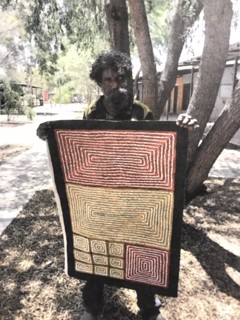Thomas Tjapaltjarri
Select Works Archive

Thomas Tjapaltjarri
Thomas Tjapaltjarri's artistry is deeply rooted in the traditions of the Pintupi people, manifesting in the form of simplistic geometric patterns and a meticulous dotting technique. This distinctive style is not unique to him alone but is a shared trait among Pintupi artists, including his siblings, Warlimpirrnga and Walala, as well as other renowned artists like Willy and George Ward Tjungurrayi. Central to Thomas's artistic narrative is the exploration of the Tingari cycle tales. The Tingari, revered as the mythological Dreamtime entities of the Pintupi culture, journeyed across the desert, establishing rituals, imparting laws, and crafting the very landscapes and sacred ceremonial sites that are integral to the Pintupi way of life. The depth and intricacy of the stories encapsulated in the Tingari paintings are profound but you'll see them expressed in a seemingly simple geometric style. While these artworks offer a glimpse into the rich tapestry of the Pintupi's ancestral lore, the full breadth of their meanings remains veiled, accessible only to those deeply initiated into the culture. In the vast expanse of Australia's Western Desert, the story of Thomas Tjapaltjarri unfolds, a tale that bridges the ancient and the modern, the traditional and the contemporary. As a member of the "Pintupi Nine" – often referred to as the "last nomads" – Thomas's life is a testament to the resilience and adaptability of the Indigenous peoples of Australia. Early Life in the Desert Born in the early 1960s, Thomas Tjapaltjarri's early years were spent living a traditional nomadic lifestyle in the Gibson Desert of Western Australia. This remote region, characterized by its vast sand dunes and sparse vegetation, was home to the Pintupi people for thousands of years. Thomas, along with his family, lived in complete isolation from Western society, relying on the land for sustenance and following age-old customs and rituals. The Pintupi Nine The "Pintupi Nine" refers to the last group of Indigenous Australians to make contact with the outside world. In 1984, this group, which included Thomas, his brothers Walala and Warlimpirrnga, and other family members, walked out of the desert and into the modern world. Their emergence was a significant event, marking the end of an era where Indigenous Australians lived entirely off the land, untouched by the influences of the outside world. The reasons for their emergence are multifaceted. As other Pintupi communities moved closer to settlements and missions during the 1950s and 1960s, the Pintupi Nine remained in the desert, continuing their traditional way of life. However, as resources became scarcer and with the encroachment of the outside world, the group eventually decided to seek out their relatives who had previously moved to settlements. Artistic Endeavors After their contact with the outside world, the Tjapaltjarri brothers were introduced to the Papunya Tula art movement. This movement, which began in the 1970s, saw Aboriginal artists from the Western Desert region translating their traditional stories and symbols onto canvas, creating a unique and vibrant form of contemporary art.Warlimpirrnga, the eldest of the Tjapaltjarri brothers, was the first to take up painting, quickly gaining recognition for his intricate designs and deep connection to his ancestral stories. Inspired by Warlimpirrnga's success, both Thomas and Walala began to explore their artistic talents. Thomas Tjapaltjarri's style is characterized by its bold geometric patterns, intricate dot work, and deep earthy tones. His paintings often depict Dreamtime stories, sacred sites, and the landscapes of his homeland. Through his art, Thomas not only preserves the rich heritage of the Pintupi people but also introduces it to a global audience. Walala, like his brothers, has also carved a niche for himself in the art world. His style, while distinct, shares similarities with Thomas's, with both brothers often using bold patterns and vibrant colors to convey their ancestral stories. Legacy and Impact The journey of Thomas Tjapaltjarri and his brothers from the remote deserts of Australia to international art galleries is nothing short of remarkable. Their art serves as a bridge between the ancient traditions of the Pintupi people and the contemporary art world. Through their paintings, they have brought attention to the rich cultural heritage of Australia's Indigenous peoples and have played a pivotal role in the global recognition of Aboriginal art. Thomas Tjapaltjarri's life story is a testament to the enduring spirit of the Pintupi people. From the vast deserts of Western Australia to the bustling art galleries of Sydney, Melbourne, and beyond, his journey, along with that of his brothers, serves as a poignant reminder of the rich tapestry of cultures that make up Australia's history. Sadly Thomas passed away in 2024.
Thomas Tjapaltjarri, a renowned Pintupi artist, crafts intricate geometric patterns using a signature dotting technique. His works vividly depict the Tingari cycle, capturing the mythological Dreamtime tales and sacred rituals of the Pintupi people.
Fill in the form below to stay up to date with new works and exhibitions by this artist.
